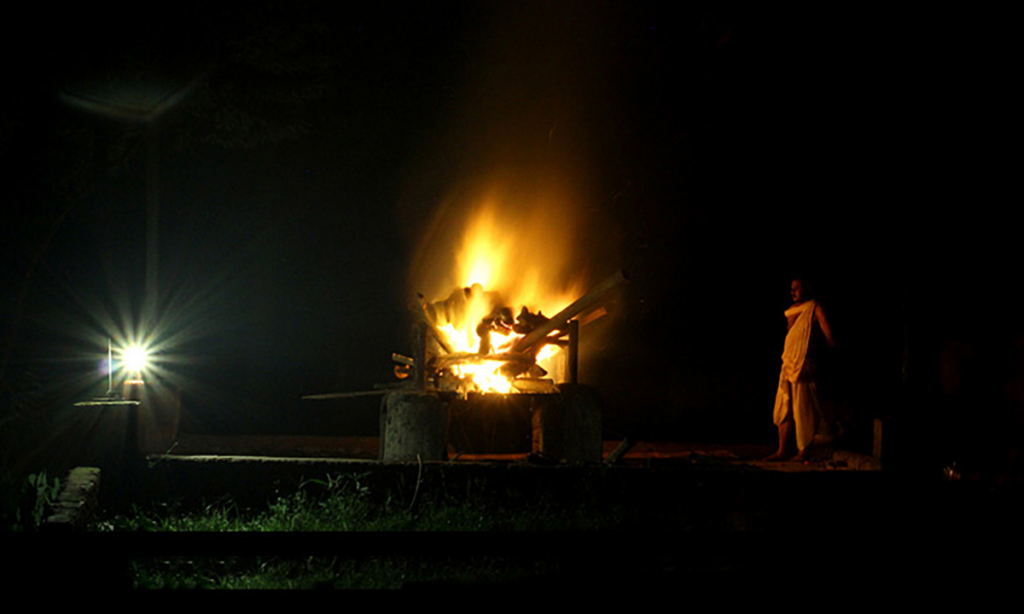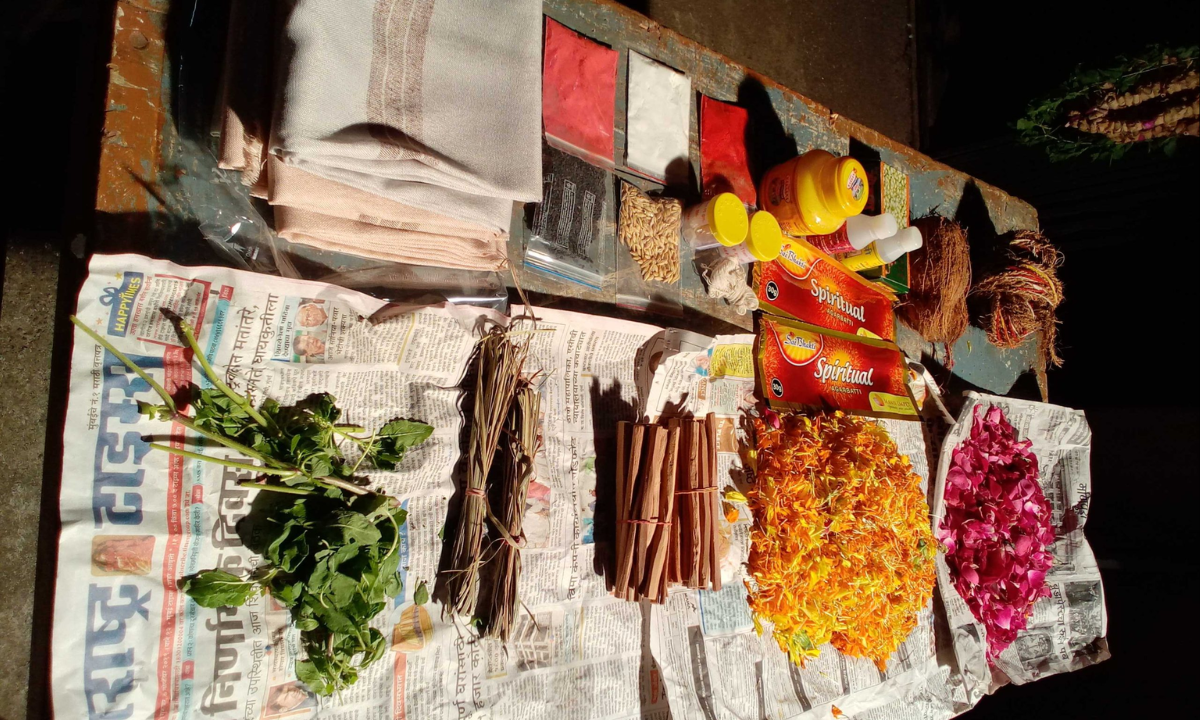No matter what, death is the truth and is the most profound part of human life. Across religions and cultures, death is not the end of physical life, but the start of a spiritual one. Among the world’s oldest religions, Hinduism places great importance on how an individual’s soul receives moksha, or liberation, through the proper administration of the last rites. Chief to these is the use of certain ceremonial materials collectively called Antim Sanskar Samagri.
In this article we are going to see that Antim Sanskar Samagri is important for all the above reasons and more in detail, what are its components and what it has to do with the Hindu belief of death and afterlife.
Understanding Antim Sanskar: The Last Rites in Hinduism

Antim Sanskar or last rites is performed in Hinduism as a ceremonial practice that takes place to honour and let go of the departed soul. These rites have a central aim — they aim to help the soul on its journey to the next realm and separate from earthly ties. Funeral services in Bangalore and other accompanying rituals taught by Hindu philosophy teach that death is not the end, but a gateway to another life, so cremation is intended to let the soul live another life in a higher spiritual realm.
All these rites are based on the ancient scriptures — Garuda Purana and Vedas — for the only purpose of the preparation of the deceased for his ultimate journey. The ritual usage of Antim Sanskar Samagri in these rituals is not solely ritualistic; it has spiritual, symbolic, and philosophical meanings from the material world to the metaphysical world.
What is Antim Sanskar Samagri?
Antim Sanskar Samagri is a collection of items used during the last rites. It makes the rituals with the Hindu customs and beliefs. The Samagri illustrates each item has a function, each element of nature, and each symbol of purity and devotion.
The Antim Sanskar Samagri contains all the necessary items like ghee, sandalwood, sesame seeds, dried cow dung cakes, camphor, Gangajal (holy water from the Ganges), ash of sacred grass (kusha), and more natural materials.
Spiritual Significance of Antim Sanskar Samagri
1. Purification of the Soul
Funeral rituals are a purification of the soul according to the Hindu tradition. It cleans the soul of all karmic impurities and how many are accumulated in its earthly existence by the use of items such as sandalwood, Gangajal, etc. These are spiritual catalysts, substances that push the soul from the mortal plane into the eternal plane.
Offered to fire (Agni) are ingredients such as ghee and sacred oils represented by Antim Sanskar Samagri. Fire is viewed as a purifier and divine bear, a conveyance of the soul’s attributes into the heavens while heaving off all its past sins.
2. Nature and the Five Elements
In Hindu philosophy, the human body is composed of five elements: five elements, earth, water, fire, air, and ether. These five elements will again take the body upon death. This is represented by ritual items in the Antim Sanskar Samagri. For instance:
- The element of earth is symbolized in sacred woods.
- Gangajal embodies water.
- Cremation fire is a reflection of consuming flames of transformation.
Because of its ability to burn cleanly without leaving a residue, camphor is air.
The rites use these materials to rejoin the body into the natural elements in a harmonious way.
3. Offerings for Ancestors and Gods to take.
Funerals in Hinduism deal with ancestors and their deities. Some items, like sesame seeds and kusha grass, are said to appease the departed ancestors (Pitrus) and the family. These are substances that form a relationship between the mortal world and the divine so that man receives a proper farewell from heaven.
4. Waiving off Karmic Debts
Karma is one of the key beliefs – or Dharmas – of Hinduism. Life is a series of karmic deeds (spiritual debts, sins, and gains). The last rites, performed with the prescribed Antim Sanskar Samagri, help to free the deceased from former debts and to give the soul peace.
Antim Sanskar Samagri-It’s Core Components
Although the specific items in Antim Sanskar Samagri may vary slightly from region to region and with different Hindu traditions, the following components are common and integral to the process:
1. Sandalwood
It also consists of light on the funeral pyre which is filled with fragrant wood called sandalwood. Spiritually its significance lies in its ability to enhance their calmness and purity plus its nice scent that complements the journey of a soul.
2. Camphor
Pure camphor is a clean burning solid that leaves behind nothing. It stands for the soul that unspins the body and has separated from all the outer objects of desire.
3. Gangajal
A belief that is, pouring holy water from the River Ganga into the mouth of the deceased, who is considered to be sanctified and obtained salvation. One of the most sacred components in Antim Sanskar Samagri.
4. Ghee
As it burns steadily the clarified butter is offered to the fire, representing nourishment for the soul going to the afterlife.
5. Sacred Grass (Kusha) and Cow Dung Cakes.
Both of them imply humility and simplicity, making us remember that nature is there to mean the key to life and death.
6. Sesame Seeds
Devotion and gratitude to our ancestors are signified by offering Sesame seeds.
Antim Sanskar Samagri – Modern Accessibility
Despite their being always in demand, victims of the sudden demise of a loved one often find a shortage of Antim Sanskar Samagri in today’s fast-moving world, especially in urban settings. For this issue, several spiritual organisations, online vendors, along local suppliers provide pre-packed Antim Sanskar Samagri. So these kits are carefully handmade with all the basic traditional items included.
Conclusion: A Pathway to Eternal Peace
Hinduism’s sacred rituals surrounding death go well beyond the normal thing, to tradition or custom. Antim Sanskar Samagri connotes profound spiritual belief in the journey of life and death, in the use of these last rites. The ingredients of the Samagri carry deep significance which leads to the binding of the natural with the spiritual world and finally takes your soul to eternal peace.
Death is an emotionally tough time for those who are left behind, but doing these rituals with the right Antim Sanskar Samagri makes one close and fulfilled. It is not solely a topic of tribute to the departed, but a reflection on the perennial cycle of life, death, and rebirth as preached in Hinduism.
Even as we accept that embracing those traditions is an honor to the departed soul, it is also reverence to the immutable truths of creation and Existence. Antim Sanskar Samagri is surely not a collection of items, but a promise of spiritual significance showing both the ones departed and the grieved a path to peace and libration.
Kaashimukthi is known for the best compassionate and dignified cremation services in Bangalore and they make sure they offer timely support to families at trying times.

Madhu is an Entrepreneur, a Mentor, a Writer and an Aspiring Car Race Driver. He is Deeply passionate about leveraging Technology and Human Centred Design to make complex care and End of Life Planning easier. With the ultimate aim of Improving the quality of Life in the Twilight years. Madhu is highly educated and Alumni of IIM-Bangalore, Sikkim Manipal University and Bangalore University besides a Rich Industry Experience in the field of Product Management, Design, Supply chain, Finance, Commercial Management and Funeral Services.

